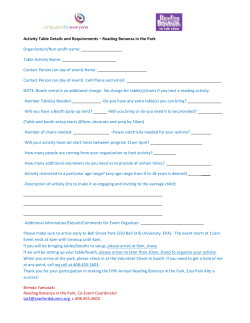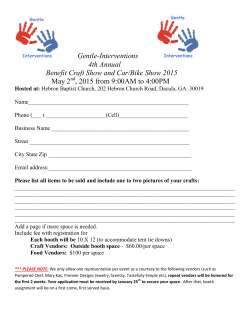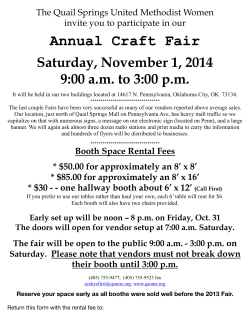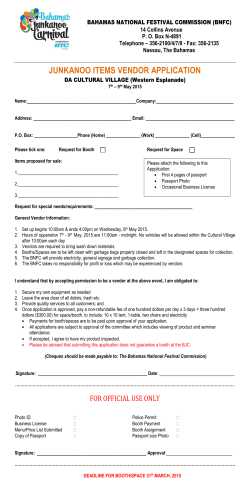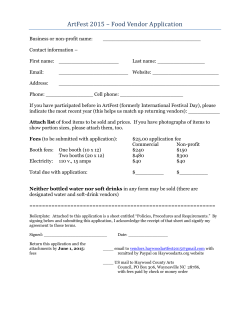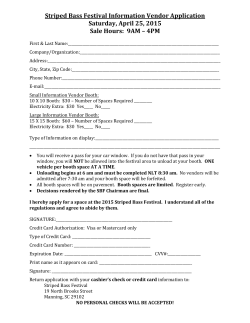
Applications - Solano County Fair
Department of Resource Management 675 TEXAS STREET, SUITE 5500 FAIRFIELD, CALIFORNIA 94533 (707) 784-6765 Fax (707) 784-4805 OFFICIAL USE ONLY SITE # _______________ - __ Rec’d by __________________ Date _____________________ Amt pd.___________________ Rcpt# ____________________ 2015 SPECIAL EVENT FOOD VENDOR APPLICATION DUE 30 DAYS BEFORE THE EVENT Applications and payments received less than 14 days prior to the event will be assessed a 50% late fee. All food vendors are required to submit a completed application for each event. Name of Event _________________________________________________________________________________________ Date(s) of Event _______________ Time of Event _____________Location of Event ________________________________ Event Organizer’s Name ______________________________ Event Organizer’s Phone ______________________________ Name of Your Business ______________________________________ Business Phone ______________________________ Business Contact Person ____________________________ Phone ___________________Email _______________________ Business Address ____________________________________ City ________________ State _____ Zip Code _____________ Temporary Food Booths - Late fees apply to applications/ payments received less than 14 days prior to the event. Fees / Late Fees ______ $102.00 / $153.00 ______ $267.00 / $400.50 ______ $47.00 / $70.50 ______ $149.00 / $223.50 Food preparation booth - Each Event Food preparation booth - Seasonal (Exp. 12/31/15) Prepackaged food booth - Each Event Prepackaged food booth- Seasonal (Exp. 12/31/15) ______ No fee Veteran’s exempt booth Status requires pre-approval by this Division ______ No fee I have a current Solano County Food Permit for a booth. Site No. __ __ __ __ __ __ ______ No fee Non-Profit food booth* 4 times per year not to exceed 72 hours each * Non-profit temporary food facilities previously approved can complete the Non-profit Temporary Food Facilities Application. Food Vehicle/Cart I have a current Solano County Food Permit for a vehicle/cart. Site No. __ __ __ __ __ __ ______ I need to obtain a current Solano County Food Permit for a vehicle/cart. ______ Required Information: I have paid all required fees and completed the Food Vendor Application, including the Food Handling Plan and Temporary Food Facility Equipment Plan . I have read and understand the "Temporary Food Facility Operating Requirements" attached with this application. I understand regulations set forth in the California Retail Food Code (Cal Code) Chapter 11 and that failure to comply with these regulations may result in immediate closure. I understand that if unpackaged food is prepared, handled, or served that an owner or person in charge (PIC) shall be present who can demonstrate adequate knowledge of food safety principles as they relate to the operation. I understand that I must post the completed “Checklist for Temporary Food Facilities” in my booth. Signed: _______________________________ Date: ____________________________ 1 Food Handling Plan Please answer all questions and list all foods being offered in chart below. Incomplete information may result in your application being denied. YES NO 1. A calibrated thermometer provided to monitor the cooking and holding temperatures of the food? 2. Food / beverage samples offered? Sampling procedures have been approved by Solano County? 3. Food prepared / stored in advance of the event? Name of establishment or cottage food operation:_________________________________________________ A current copy of the permit/registration is provided with this application? 4. All food purchased on the day of the event and prepared in the booth? If yes, operator agrees to provide a receipt or invoice for proof of same day purchase on the day of the event. 5. I understand that food prepared/ stored at a private home or other unapproved location is prohibited. Food / beverage Sold prepackaged? Time in Transport Hot/cold holding EQUIPMENT (during transport) Cooking/reheating EQUIPMENT Hot/cold holding EQUIPMENT (during event) 2 Temporary Food Facility Equipment Plan All booth vendors shall complete this section including those selling or serving prepackaged food. NOTE: The only operations not requiring fully enclosed booths are those that sell prepackaged food items or food product from approved bulk dispensers (food compartments). Prepackaged foods must be sold in the original packaging with proper labels. Vendors that are distributing samples may be required to have a fully enclosed booth. Contact this Department if you have any questions. 1. Is your booth fully enclosed from floor to ceiling? Yes _____ No _____ 2. Service openings are no larger than 216 square inches (18” X 12”) and are at least 18” apart? Yes _____ No _____ 3. Tarp (smooth and cleanable material) on the ground? Yes _____ No _____ 4. Signage: Name of operator, business, city, state, and zip code are clearly visible to patrons? Yes _____ No _____ BOOTH DRAWING: In the space below, provide a drawing of your booth. Identify and describe all equipment, including cooking and holding equipment, handwashing facilities, work tables, utensil washing sink (containers), food and paper product storage, garbage containers, and customer service areas (see example below). The only items that are allowed outside the booth are an open air BBQ and a cooler for storage of raw meat at the grill. All other cooking equipment and washing facilities shall be inside the booth. EXAMPLE: PREP TABLE TRASH W R S 3 BUCKETS FOR WASHING UTENSILS FOOD STORAGE HANDWASH STATION BBQ 10’ PASS THROUGH WINDOW CHAFING DISH COUNTER NOTE: If cooking equipment will be used inside of booth, contact the local Fire Department for booth requirements. You may be required to have a fire extinguisher, certified flame-resistant materials and/or a portable fire suppression system in your booth. SERVICE WINDOWS 10’ BOOTH FLOOR PLAN 3 Department of Resource Management 675 TEXAS STREET, SUITE 5500 FAIRFIELD, CALIFORNIA 94533 (707) 784-6765 Fax (707) 784-4805 TEMPORARY FOOD FACILITY SELF-INSPECTION CHECKLIST Please do not return this checklist to Resource Management with your application. POST INSIDE THE BOOTH YES 1 2 3 NO N/A FOOD SOURCE AND TEMPERATURE Source: All food shall be obtained from a permitted commercial or retail food establishment (store or restaurant). Food stored or prepared at home or other unapproved location is prohibited. Preparation: All food shall be stored and prepared at a permitted food establishment or within the permitted temporary food booth. Thawing: Food shall be thawed in the refrigerator at 41ºF or less, submerged in running water at 70ºF or less, in a microwave, or as part of the cooking process. Holding Temperatures: Potentially hazardous foods shall be maintained hot at 135ºF or higher, or cold at 45ºF or below. Frozen food cannot be used to chill other products. If using an ice chest, ice must be used in sufficient quantity to maintain proper food temperatures (45ºF or less). Cooking Temperatures: Food shall be cooked to the minimum internal temperatures specified below: *165ºF for 15 seconds for poultry, any stuffing containing fish, beef, pork or poultry, or stuffed fish, beef, pork or poultry. *155ºF for 15 seconds for ground fish and ground meat (hamburgers) *145ºF for 15 seconds for eggs or dishes containing raw egg, whole fish, and whole meat Reheating for Hot Holding: Previously cooked, cooled, and reheated foods shall be reheated to an internal temperature of 165ºF. Thermometer: A probe thermometer with a temperature range of 0ºF-220ºF for measuring food holding and cooking temperatures is required. PERSONNEL Health: All employees are healthy. Employees with cuts or sores on their hands shall wear gloves in addition to proper handwashing. Employees experiencing vomiting and/or diarrhea must be excluded from food related activities. Handwashing: Handwashing facilities shall be provided inside the booth (adequate potable warm water in a container with a spigot, with catch bucket for wastewater, soap and paper towels). Hygiene: Food workers shall maintain personal cleanliness, wash hands frequently, wear clean clothing, and wear hair restraints. Food Preparation: Gloves, tongs, deli paper, spatulas or other dispensing equipment are used when handling ready-to-eat foods. FOOD AND UTENSIL STORAGE AND HANDLING Hot and Cold Storage: Necessary equipment and supplies to maintain proper food temperatures, 45ºF or less for cold foods, 135ºF or above for hot foods (i.e. sufficient ice, a means of obtaining ice throughout operation, sufficient heating fuel). Storage: All food and equipment (except BBQs) shall be stored inside the booth and at least 6 inches off the ground. Bulk items protected from contamination by a solid waterproof barrier may be stored on the ground (e.g. ice chest). Food Storage During Multiple Day Events: During periods of inoperation, potentially hazardous foods shall be stored in a refrigerator at an approved location. All other food shall be stored in sealed containers inside a permitted food establishment. 4 4 5 6 7 CHECK LIST REQUIREMENTS Customer Self-Service: Condiments must be dispensed in single service type packaging, in pump-style dispensers, squeeze bottles, shakers, or similar dispensers. Food Display: All food shall be protected from customer handling, coughing, sneezing, or other contamination. All cooking and serving areas shall be protected from contamination. BBQs should be roped off or otherwise separated from the public. Food sampling shall be conducted in a sanitary manner (see Sampling Guidelines). Utensil Storage: In-use food dispensing utensils must be stored in the food with their handles above the food. Wash and sanitize all utensils before storing. Store clean utensils in a sanitary location protected from contamination. Cross Contamination: Food shall be protected from cross contamination by separating raw animal foods from ready-to-eat foods during storage, preparation, holding, and display. CLEANING Warewashing: Provide either a bucket system (Appendix A) or a three-compartment sink with potable running water for warewashing. Sanitizing shall occur in the final step of the cleaning process with a solution of proper concentration (bleach solution at 100 ppm chlorine, or quaternary ammonium at 200 ppm). Wiping Cloths: Wiping cloths shall be used once then laundered or thrown away, or shall be stored in a clean sanitizing solution of proper concentration (see concentration of warewashing above) between uses. WATER SUPPLY AND WASTEWATER DISPOSAL Water: An adequate supply of warm and cold potable water shall be available on site for cooking, cleaning, sanitizing, handwashing and drinking. At least 20 gallons per booth per day for utensil and handwashing are required. Water supply hoses must be made from food grade materials (garden hoses are prohibited). YES NO N/A Wastewater Disposal: Wastewater will be disposed of in an approved wastewater disposal system (mop sink, toilet, wastewater tank) located at ______________. Wastewater may not be dumped onto the ground surface, into waterways, or into storm drains. PREMISES Garbage: Leakproof and insect-proof garbage containers with plastic garbage bags shall be provided. Waste Grease: Waste grease shall be disposed of into a serviceable tallow bin or in another approved manner. Lighting: Adequate lighting shall be provided. FOOD BOOTH Tables, Counters and Shelves: Tables, counters, food prep surfaces, and shelves shall be smooth, easily cleanable and nonabsorbent. Enclosure: Booth shall consist of four complete sides and a top (plywood, canvas, plastic or fine mesh fly screen) and shall enclose all food and equipment. Note: Local Fire Dept may require proof of fire retardant materials. Identification: Facility name, operator name, city, state and zip code shall be posted in a location clearly visible to patrons. Floor: Cleanable floor surfaces (tarp or other cleanable material) shall be provided. Access Doors and Pass-thru Windows: Tight-fitting closures for access doors openings are required. Pass-thru windows are closeable and not larger than 18” X 12”. Fire Safety: Check with local Fire Department regarding necessary fire extinguishers and fire codes related to food booths. Provisions for Wind: Weights to hold booth in place in high winds may be needed. I have provided all of the above for the operation of my food booth. I understand that failure to provide all to the above items may result in immediate closure of my booth. I understand that I must post this completed checklist inside my booth. Signed: ________________________________________________ Date: _________________________________ 5 Department of Resource Management 675 TEXAS STREET, SUITE 5500 FAIRFIELD, CALIFORNIA 94533 (707) 784-6765 Fax (707) 784-4805 Temporary Food Facility Operating Requirements Please read this guideline carefully. These requirements have been established to be consistent with State and local health code requirements and are intended to assist you in providing safe and wholesome food to the public. Food booths are required to comply with all of the requirements of this guideline. Failure to comply may result in closure of your booth and/or a citation to appear at an administrative hearing. I. Temporary Food Booth Operating Requirements: Temporary Food Booths must operate in conjunction with a single, weekly, or monthly community event. A community event is an event that is of a civic, political, public, or educational nature, including state and county fairs, city festivals, circuses, and other similar events. A community event does not include a swap meet, flea market, seasonal sporting event, grand opening celebration, anniversary celebration, certified farmers market, or similar function. II. Food Handling - Sanitary Requirements: A. Food Preparation 1. All food handling and preparation shall take place within a food booth unless approval of a different preparation site has been obtained from the Environmental Health Division (e.g. restaurants, delicatessens, permitted church or school kitchens). B. 2. Food prepared or stored at home is prohibited from use. Except for approved food items prepared in a registered or permitted cottage food operation, food prepared at home will not be allowed for service or sale and will be impounded if not voluntarily discarded. 3. Open flame BBQs used for open flame cooking only, are allowed outside of the booth. No other equipment is allowed outside of the booth for cooking (e.g. grills, griddles, deep fat fryers). BBQs shall be separated from public access by using ropes or other approved methods to prevent contamination of food and injury to the public. 4. Deep fat fryers, grills, griddles, etc., may require separate screened areas in accordance with local fire codes. 5. Food preparation surfaces must be smooth, easily cleanable and nonabsorbent (commercial cutting boards are required). Temperature Control - Adequate temperature control shall be provided for all perishable (potentially hazardous) foods. Provide a metal probe thermometer that is capable of registering 0F -220F to check temperatures. 1. Cold Foods – Maintain a temperature of 45F or below for up to 12 hours in any 24-hour period. Foods that are held greater than 12 hours shall be maintained at 41F or below. A refrigerator or an ice chest may be used to store potentially hazardous foods provided that ice is adequately supplied 6 and distributed to ensure proper temperatures. Thermometers are required inside all refrigeration units. Frozen food cannot serve as its own refrigerant. At the end of the operating day, cold perishable food shall be placed in mechanical refrigeration units that maintain the food at or below 41F or the food shall be destroyed in a manner approved by the local enforcement agency. 2. Hot foods - Maintain food temperatures of 135F or above. At the end of the operating day, food that has been held at or above 135F shall be discarded. 3. Food in transit must be protected from contamination and must meet the temperature requirements noted above. 4. Frozen food shall be defrosted in one of the following ways only: (a) In a microwave (b) Under running water for no more than two hours (c) In a refrigeration unit (d) As part of the cooking process. NOTE: C. Sufficient equipment necessary to cook and maintain required temperatures for all perishable food shall be provided (e.g. steam tables, chafing dishes, refrigerators, coolers). The equipment shall be certified or classified for sanitation by an American National Standards Institute accredited program.. Utensil Washing Facilities The figure below illustrates a sample dishwashing/sanitizing and hand washing equipment set-up. 1. Booths with food preparation require a stainless steel utensil-washing sink with at least three compartments with two integrally installed stainless steel drain boards. The sink compartments and drain boards shall be large enough to accommodate the largest utensil or piece of equipment to be cleaned in the sink. The sink shall be provided with hot and cold running water from a mixing valve. The sink shall be located within each temporary food facility. Subject to availability. For alternatives, see Appendix A. 2. Shared utensil washing facilities provided by the event organizer may be allowed, however, the bucket system (shown in appendix A) will still be required within each booth. 3. Cleaning cloths and/or sponges used to wipe counters, cutting boards, and other surfaces that may directly or indirectly contact food shall be held in a sanitizing solution when not in use, and may be used repeatedly. The proper concentration of the sanitizing solution shall be 100 ppm available chlorine (approximately one tablespoon bleach per gallon of water), or 200 ppm quaternary ammonium. 7 D. Hand Washing Facilities - Hand washing facilities, separate from the utensil-washing sink, shall be provided. The hand washing facilities shall be located within each temporary food facility. The hand washing facility shall be equipped with warm (of at least 100 °F but not greater than 108°F) running water. Hand washing cleanser and single-use sanitary towels shall be provided in dispensers at each hand washing facility. Hand soap may be provided in a pump- style bottle. Liquid dish detergent is not acceptable for hand washing purposes. See Appendix A. E. Water F. G. 1. An adequate supply of potable hot and cold water shall be provided for utensil washing, hand washing, and janitorial purposes. Hot water of at least 120F must be supplied. The potable water supply shall be from an approved source and be protected with a backflow or back siphonage protection device, as required by applicable plumbing codes. 2. In addition to the water needed for food preparation and dispensing, at least 20 gallons of potable warm water shall be provided per temporary food facility per day of operation for utensil washing and hand washing. 3. The inlet to a potable water tank shall be provided with a connection of a size and type that will prevent its use for any other service, and shall be constructed so that backflow and other contamination of the water supply is prevented. Hoses used to fill potable water tanks shall be made of food grade materials (not garden hoses) and handled in a sanitary manner. Wastewater 1. Ice melt and other liquid wastes, including waste from beverage dispensing units, must be contained in or drained into an approved leakproof container. The liquid waste tanks shall have a minimum capacity that is 50 percent greater than the potable water tanks. 2. Liquid waste must be disposed of into an approved sewage system or holding tank and shall not be discharged onto the ground or into a storm drain. The event organizer shall provide you with a location for liquid waste disposal. Food Handlers 1. Food handlers must be in good health. Permit holder shall require food employees to report illnesses as required. 2. Food handlers shall wash their hands and arms with soap and warm water prior to the start of food preparation activities and at other times as necessary to prevent food contamination and especially after visiting the restroom. 3. Clean aprons or outer garments must be worn and hair must be restrained. 4. Sanitary food handling techniques must be used at all times. Food handlers shall not contact exposed, readyto-eat food with their bare hands and shall use suitable utensils (deli tissue, tongs, disposable gloves, etc.) to avoid doing so. 5. Facilities that prepare, handle or serve unpackaged food shall have an owner or person in charge present who can demonstrate adequate knowledge of food safety principles as they relate to their specific operation. 8 H. Ice - Ice used for refrigeration cannot be used for consumption. Ice used for consumption must be protected from contamination. I. Condiments – Self-service condiment containers shall be the pump type, squeeze containers, or have selfclosing covers or lids for content protection. Single service packets are recommended. J. Toilet Facilities 1. At least one toilet facility for each 15 booth employees shall be provided with 200 feet of each temporary food facility. 2. Each toilet facility shall be provided with approved hand washing facilities. Hand washing cleanser and single-use sanitary towels shall be provided in permanently installed dispensers at each hand washing facility. K. Smoking - Smoking is prohibited in food booths. L. Storage/Service M. 1. All food, beverage, utensils, and equipment shall be stored, displayed and served so as to be protected from contamination and shall be stored at least six inches off the floor. 2. During periods of inoperation, food shall be stored in one of the following methods: (a) Within a fully enclosed food booth (b) In lockable food storage compartment meeting both of the following conditions: (1) The food is adequately protected at all times from contamination, exposure to the elements, entrance of rodents and other vermin, and temperature abuse. (2) The storage compartment has been approved by this Department. (c) Within a permitted food facility or other facility approved by this Department 3. An area separate from food preparation, utensil washing, and food storage areas shall be provided for the storage of employee clothing or other personal effects. Garbage and Refuse 1. Garbage and refuse must be stored in leak proof and fly proof containers and serviced as needed. Plastic garbage bags are recommended in each booth. 2. The Environmental Health Division must approve arrangements for cleanup and final disposal of all solid waste. N. Animals - Live animals, birds, or fowl are not permitted within 20 feet of temporary food facilities. O. Lighting - Adequate shatterproof lighting shall be provided. P. Open-Air BBQ Facilities - Open-Air BBQ facilities may be operated in conjunction with a permitted, fully enclosed booth. The BBQ must be used for cooking, roasting or broiling over live coals (wood, charcoal or gas heated). The BBQ may not be used for cooking foods, warming foods or maintaining food temperatures in pots, skillets or other containers. All other food preparation and storage and equipment storage shall be kept inside the fully enclosed booth. NOTE: Flat grills, gas powered heating/warming units, or electrical 9 grills are not allowed for food preparation outside the booth. III. Food Booths: Except as provided below, the booth must be entirely enclosed with four complete sides, a top and cleanable floor. 1. Booths that handle unpackaged food must use a waterproof cleanable tarp or similar material for floor surfaces. 2. Ceilings shall be smooth, durable, and readily cleanable. Screening shall only be acceptable as a ceiling material above cooking equipment or when necessary for ventilation purposes. 3. Food service openings shall not be greater than 216 sq. in. (12”x18”) and be equipped with tightfitting closures to minimize the entrance of insects. 4. Food operations that have adjoining BBQ facilities shall have a pass through window at the rear or side of booth. 5. All food and equipment shall be stored inside the fully enclosed booth with the exception of outdoor BBQ facilities. Construction materials such as plywood, canvas, plastic, and fine-mesh fly screening (at least 16 mesh) may be used. When open flame or heat producing equipment is used, fire/heat retardant materials (screening) shall be used. NOTE: The only operations not requiring fully enclosed booths are those which sell beverages from approved dispensers or food items prepackaged by a wholesaler or at an approved off-site kitchen. These items must be sold in the original packaging. Food preparation such as blending, cutting, popping, combining ingredients or mixing requires a fully enclosed booth. Vendors that distribute samples may be required to have a fully enclosed booth. 6. Signage that includes the facility name, operator name, city, state, and zip code of the business shall be legible and clearly visible to patrons. The facility name shall be in letters at least 8 centimeters (3 inches) high, and shall be of a color contrasting with the temporary food facility. Letters and numbers for the city, state, zip code and the name of the permittee shall not be less than 2.5 centimeters (1 inch) in height. 10 APPENDIX A The following sections correspond to sections C, D and E of the Guideline. With prior approval by this Department, the following alternatives may be allowed for temporary food booths if the required equipment is not available. C. Utensil Washing Setup: Booths with food preparation require three clean five-gallon containers for cleaning of equipment and utensils. A fourth may be required for general cleaning purposes. One container shall contain soapy water (wash), the second clean water (rinse) and the third a bleach/water solution (sanitize): one tablespoon of household bleach per gallon of water. D. Hand washing facilities: Provide a minimum five- gallon container with warm water (at least 100˚F), a dispensing valve (spigot), which will leave hands free for washing. Provide a waste-water container, hand soap and paper towels in dispensers. Additional Facilities: Additional and separate facilities may be required for the washing of food, fruits, and vegetables with potable water prior to preparation. E. Wiping Cloths/Towels: All in-use wiping cloths shall be held in sanitizing solution between uses. F. Water: A minimum of 20 gallons (30 gallons for facilities preparing food and washing utensils) of potable warm water shall be provided for utensil washing and hand washing. The water supply shall be from a source approved by the enforcement agency. 11
© Copyright 2026
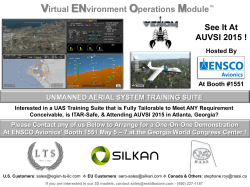

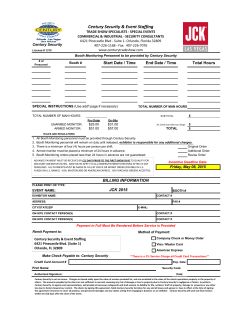
![[ARTSFEST 2013 LOGO HERE] - Charles County Arts Alliance](http://cdn1.abcdocz.com/store/data/001015101_1-9f0a18406a43f53c7b2e4af0326cef3a-250x500.png)
